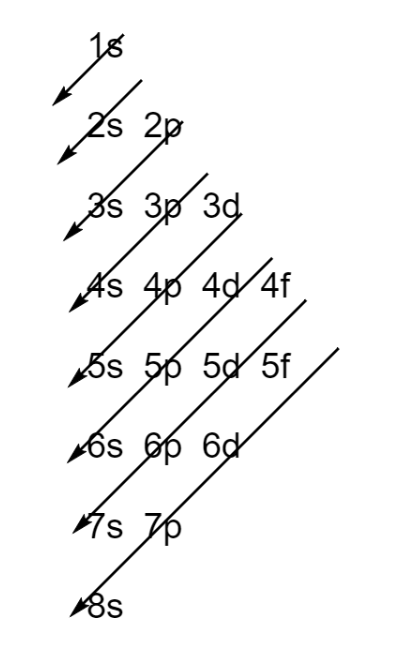
What is the ground state configuration of chlorine?
Answer
428.4k+ views
Hint: The electronic configuration of any neutral atomic species is used to describe and understand the structure of an atom. It can be written by assigning the number of electrons to specified orbitals and a set of rules known as the Aufbau principle, Hund’s rule, and Pauli exclusion principle are followed in doing so. The atomic number of chlorine is 17.
Complete answer:
The atoms consist of many subatomic particles including electron, proton, neutron, etc. Each kind of atom has its own arrangement of these subatomic particles. But every arrangement follows certain rules. The arrangement of electrons in the atomic orbitals is known as the electronic configuration.
Also, every system in the universe prefers to attain the lowest energy. Similarly, the lowest energy and most stable state of electronic configuration is called ground state configuration.
Let us write the electronic configuration of chlorine.
Step 1- Find the number of electrons:
It is a group 17 element and its atomic number is 17. It means that it possesses 17 protons and 17 electrons.
Step 2 – Fill the atomic orbitals using Aufbau’s principle. It states that electrons must fill the lowest energy orbital first according to the scheme given below.

Hence, the ground state configuration of chlorine is $\text{1}{{\text{s}}^{\text{2}}}\text{2}{{\text{s}}^{\text{2}}}\text{2}{{\text{p}}^{\text{6}}}\text{3}{{\text{s}}^{\text{2}}}\text{3}{{\text{p}}^{\text{5}}}$.
Note:
The other two rules followed in writing electronic configuration are Hund’s rule and the Pauli exclusion principle. Hund’s rule states that electrons must not be paired in the orbitals until each orbital contains one electron, and no orbital can have two electrons with the same spin.
And, Pauli Exclusion Principle states that no two electrons can have the same quantum numbers $\left( \text{n, l, }{{\text{m}}_{\text{l}}},\text{ }{{\text{m}}_{\text{s}}} \right)$.
Complete answer:
The atoms consist of many subatomic particles including electron, proton, neutron, etc. Each kind of atom has its own arrangement of these subatomic particles. But every arrangement follows certain rules. The arrangement of electrons in the atomic orbitals is known as the electronic configuration.
Also, every system in the universe prefers to attain the lowest energy. Similarly, the lowest energy and most stable state of electronic configuration is called ground state configuration.
Let us write the electronic configuration of chlorine.
Step 1- Find the number of electrons:
It is a group 17 element and its atomic number is 17. It means that it possesses 17 protons and 17 electrons.
Step 2 – Fill the atomic orbitals using Aufbau’s principle. It states that electrons must fill the lowest energy orbital first according to the scheme given below.

Hence, the ground state configuration of chlorine is $\text{1}{{\text{s}}^{\text{2}}}\text{2}{{\text{s}}^{\text{2}}}\text{2}{{\text{p}}^{\text{6}}}\text{3}{{\text{s}}^{\text{2}}}\text{3}{{\text{p}}^{\text{5}}}$.
Note:
The other two rules followed in writing electronic configuration are Hund’s rule and the Pauli exclusion principle. Hund’s rule states that electrons must not be paired in the orbitals until each orbital contains one electron, and no orbital can have two electrons with the same spin.
And, Pauli Exclusion Principle states that no two electrons can have the same quantum numbers $\left( \text{n, l, }{{\text{m}}_{\text{l}}},\text{ }{{\text{m}}_{\text{s}}} \right)$.
Recently Updated Pages
The correct geometry and hybridization for XeF4 are class 11 chemistry CBSE

Water softening by Clarks process uses ACalcium bicarbonate class 11 chemistry CBSE

With reference to graphite and diamond which of the class 11 chemistry CBSE

A certain household has consumed 250 units of energy class 11 physics CBSE

The lightest metal known is A beryllium B lithium C class 11 chemistry CBSE

What is the formula mass of the iodine molecule class 11 chemistry CBSE

Trending doubts
State the laws of reflection of light

Arrange Water ethanol and phenol in increasing order class 11 chemistry CBSE

Name the nuclear plant located in Uttar Pradesh class 11 social science CBSE

One Metric ton is equal to kg A 10000 B 1000 C 100 class 11 physics CBSE

Difference Between Prokaryotic Cells and Eukaryotic Cells

A mixture of o nitrophenol and p nitrophenol can be class 11 chemistry CBSE




